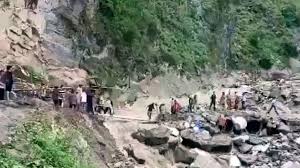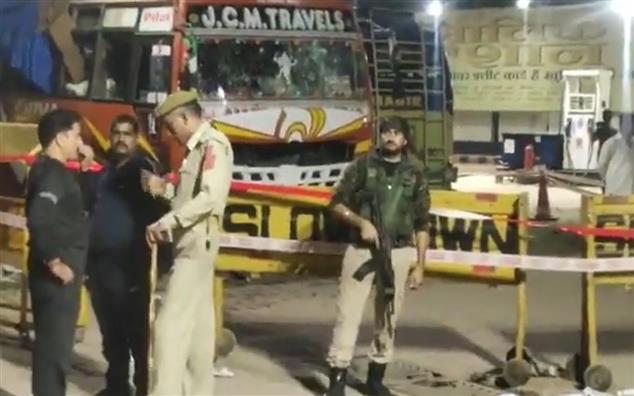An in-depth look at the disaster, the people it affected, and the road to recovery.
By: Javid Amin | Jammu | 14 Aug 2025
A Journey Interrupted by Nature’s Fury
On what was supposed to be a day of devotion and celebration, hundreds of pilgrims began their ascent toward the sacred Machail Mata temple in Jammu and Kashmir’s Kishtwar district. The air was filled with chants, the clinking of walking sticks on rocky paths, and the aroma of hot tea and prasad from roadside langars.
But by early afternoon on August 14, 2025, the skies darkened ominously over Chositi village, the last motorable point before the 8.5-kilometer trek to the shrine. Within minutes, the heavens unleashed a torrential fury — a massive cloudburst that sent walls of water, mud, and debris hurtling down the mountainside.
By the time the rain stopped, at least 37 people lay dead, over 100 were injured, and many more were missing. The Machail Mata Yatra, an annual spiritual journey for thousands, had turned into a scene of chaos, grief, and desperate rescue operations.
Timeline of the Disaster
⏳ Morning: Hope & Faith
-
Pilgrims began gathering at Chositi as early as 6:00 am.
-
Langars offered tea, snacks, and meals to devotees before they began the steep trek to the temple.
-
Weather in the morning was cloudy but calm.
⏳ 12:00–1:00 pm: Nature Strikes
-
Dark clouds gathered rapidly over the village.
-
Within minutes, intense rainfall hit the area — much stronger and more concentrated than normal monsoon showers.
-
Locals recall a deafening sound, “like a thousand drums,” followed by roaring water rushing downhill.
⏳ Immediate Aftermath
-
A langar tent was swept away entirely.
-
Mud and debris buried sections of the path.
-
People screamed for loved ones, many trapped under collapsing structures.
-
The Central Industrial Security Force (CISF) lost one official, while three others went missing during their temporary deployment for yatra security.
⏳ 1:30 pm Onwards: Rescue Begins
-
Police, SDRF, and NDRF teams were deployed despite difficult terrain.
-
Locals formed human chains to pull survivors from the debris.
-
Helicopters were readied, but heavy rain delayed air rescue.
Machail Mata Yatra — The Sacred Pilgrimage
The Machail Mata temple, situated at an altitude of 9,500 feet in the Paddar region of Kishtwar, is one of the most revered Hindu shrines in Jammu & Kashmir. Every year in August, thousands of devotees trek to the shrine, which is dedicated to Goddess Chandi.
The route is scenic yet challenging — narrow mountain roads, wooden bridges over rivers, and steep paths often cut into cliff faces. For many pilgrims, the journey is not just religious but deeply personal — an act of faith, penance, or thanksgiving.
Chositi village marks a transition point: here, vehicles stop, and pilgrims begin the uphill climb. It’s also where many rest, eat, and refuel spiritually before tackling the final stretch.
Unfortunately, this geographical bottleneck meant that when the cloudburst struck, hundreds were in the danger zone at once.
Understanding a Cloudburst
A cloudburst is an extreme weather event where an unusually high amount of rain — often more than 100 mm per hour — falls over a very small area. In mountainous regions like Kishtwar, the steep slopes channel the water quickly into flash floods.
Why they are deadly here:
-
Narrow valleys funnel water at high speed.
-
Loose soil and deforestation make landslides more likely.
-
Pilgrim gatherings increase vulnerability, as large groups often camp in low-lying areas.
Experts say cloudbursts are becoming more frequent in the Himalayas, partly due to climate change altering monsoon patterns.
Eyewitness Accounts — “We Saw the River Rise in Minutes”
-
Rajesh Kumar, a survivor from Punjab:
“One minute we were eating at the langar, and the next, water was everywhere. I grabbed my wife’s hand, but the current was so strong. I don’t know how we made it.” -
Meena Devi, local shopkeeper:
“I’ve seen heavy rain before, but this was different. The sound… it was like the mountain was breaking apart.” -
A CISF jawan’s colleague:
“We were on duty to protect the pilgrims. We never thought we’d have to fight for our own lives.”
These stories capture not just the horror of the moment but also the fragility of life in the mountains.
6. The Rescue Mission — Heroes Amid the Chaos
When the cloudburst struck, the narrow lanes of Chositi turned into gushing torrents. The terrain made it almost impossible for heavy machinery to reach quickly, so the first responders were locals — shopkeepers, pony handlers, langar volunteers, and even fellow pilgrims.
Local Courage
Armed with nothing more than ropes and wooden sticks, villagers formed human chains to pull people from the debris. Many risked their lives entering waist-deep, muddy floodwaters to reach the injured.
Mohammad Shafi, a pony owner, recounted:
“I pulled out three people before the current swept my pony away. I don’t know if it survived. In moments like this, you think only about the human beings in front of you.”
Official Response
-
NDRF (National Disaster Response Force) teams were dispatched from Kishtwar and Doda.
-
SDRF (State Disaster Response Force) teams brought in portable medical kits and stretchers.
-
Army units stationed in the region provided logistical support, including tents for sheltering survivors.
-
Helicopter rescues were attempted, but low visibility delayed operations until late evening.
By nightfall, 65 people had been rescued, though many remained unaccounted for.
The Toll — Counting the Losses
As of the latest official figures:
-
37 confirmed dead — most of them pilgrims.
-
100+ injured, many with fractures, head injuries, and hypothermia.
-
Several missing, including three CISF personnel.
-
One langar site completely destroyed.
-
Dozens of temporary shops and tents swept away.
Doctors at district hospitals reported a shortage of trauma care facilities, leading to emergency medical evacuations to Jammu.
Impact on Pilgrimage & Local Economy
The Machail Mata Yatra is not just a spiritual event — it is the economic lifeline for many in Kishtwar and Paddar.
-
Pony owners transport pilgrims.
-
Shopkeepers sell food, clothes, and offerings.
-
Langar operators rely on donations from visitors.
With the yatra suspended indefinitely, many locals face severe income loss in the peak season.
Political & Administrative Response
Union Minister Dr. Jitendra Singh immediately contacted Kishtwar Deputy Commissioner Pankaj Kumar Sharma after being alerted by local MLA Sunil Kumar Sharma.
He posted on X:
“Massive cloud burst in Chositi area, which could result in substantial casualty. Administration has immediately swung into action. Rescue teams are on-site. All possible assistance will be provided.”
The J&K administration has announced:
-
₹5 lakh ex gratia to families of the deceased.
-
₹50,000 for the injured.
-
Free medical care for survivors.
Opposition leaders have called for a comprehensive disaster management plan for pilgrimage routes in the Himalayas.
Why Kishtwar is Vulnerable
Kishtwar lies in the Chenab Valley, part of the western Himalayas — a region known for steep slopes, fragile rock formations, and heavy monsoon rainfall.
-
Glacial streams swell rapidly during rain.
-
Unplanned construction on slopes weakens the soil.
-
Deforestation reduces natural absorption of rainwater.
In simple terms — this is a disaster-prone geography where a cloudburst can turn deadly within minutes.
Climate Change & Extreme Weather
Scientists warn that climate change is intensifying cloudburst events. Rising temperatures cause more water vapor to accumulate in clouds, leading to sudden, intense downpours.
Data from the India Meteorological Department (IMD) shows:
-
The western Himalayas have seen a 15% increase in extreme rainfall events in the last two decades.
-
Unseasonal cloudbursts are becoming more common outside the peak monsoon months.
Challenges in Rescue Operations
Rescuers faced multiple obstacles:
-
Blocked roads due to landslides.
-
Continuous rain making the ground unstable.
-
Poor mobile network hampering coordination.
-
Lack of night-time rescue infrastructure in remote mountains.
These challenges highlight the urgent need for specialized mountain disaster units in J&K.
Safety Lessons for Pilgrims
Disaster experts recommend:
-
Checking weather updates before starting the trek.
-
Avoiding camping in river valleys or directly below steep slopes.
-
Carrying basic emergency kits (torch, whistle, waterproof poncho).
-
Following official advisories during the yatra.
If this incident teaches anything, it’s that faith must go hand in hand with preparedness.
Recovery & Rehabilitation Plans
Authorities have promised:
-
Permanent shelters in Chositi for future yatras.
-
Early warning systems for cloudbursts and flash floods.
-
Strengthening bridges and trekking paths to withstand extreme weather.
Rebuilding will take months, but locals hope it will make the route safer for future generations.
Past Cloudburst Disasters in J&K
-
Amarnath Yatra, 2022 — Cloudburst killed 16, injured dozens.
-
Leh, 2010 — Flash floods after a cloudburst killed over 200.
-
Poonch, 2017 — 7 killed in sudden flash floods.
Each incident brings promises of better safety — but implementation often lags.
Public Reactions & Social Media
Within hours, hashtags like #KishtwarCloudburst, #PrayForJammuKashmir, and #MachailMata trended on X and Instagram.
-
Many shared helpline numbers and donation links.
-
Videos of the rescue efforts went viral, showing extraordinary bravery by locals and security forces.
-
Social activists called for long-term climate resilience planning in the Himalayas.
Conclusion — A Prayer for Healing
The Kishtwar cloudburst is a sobering reminder of the delicate balance between human activity and nature in the mountains. Pilgrimages like the Machail Mata Yatra are journeys of faith — but in an era of climate change, faith must be accompanied by foresight.
As survivors mourn their loved ones and communities begin to rebuild, the hope is that this tragedy will push authorities to create safer pilgrimage routes and stronger disaster preparedness systems — so that devotion can flourish without fear.



